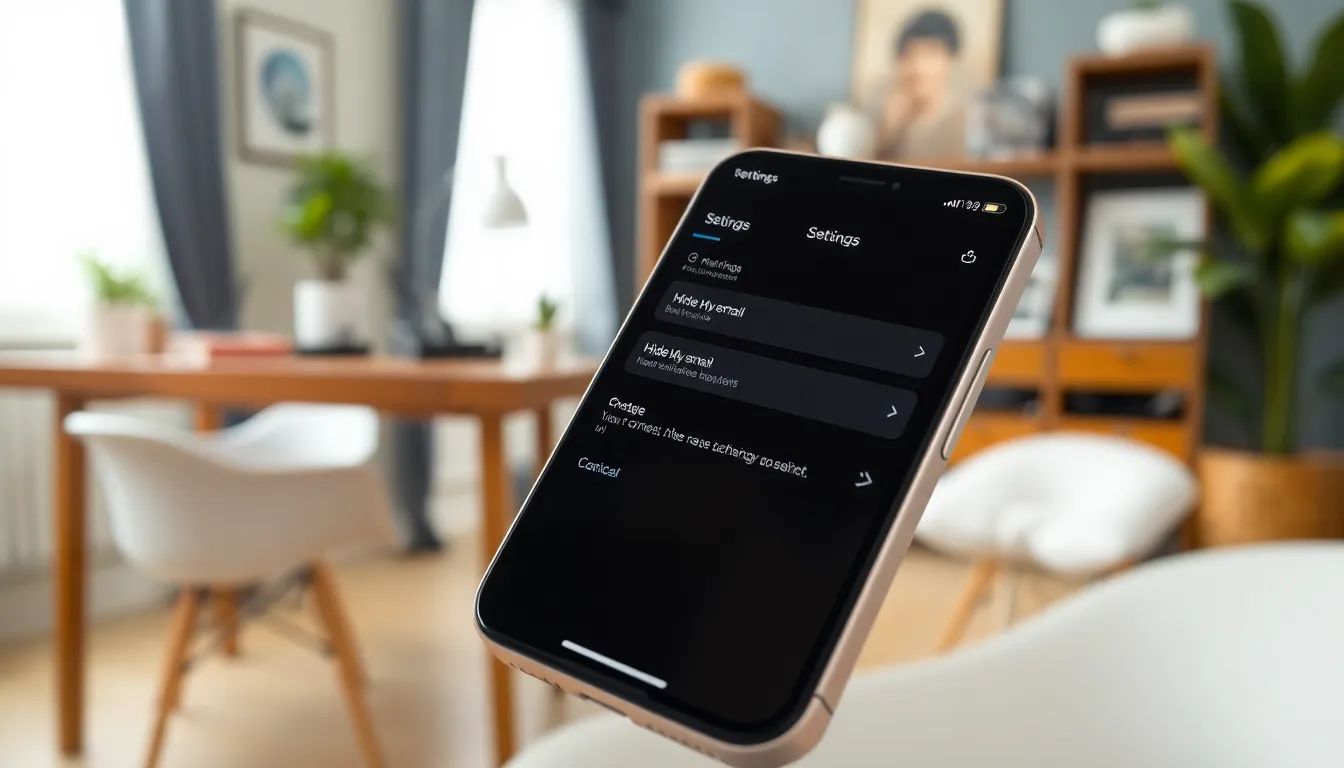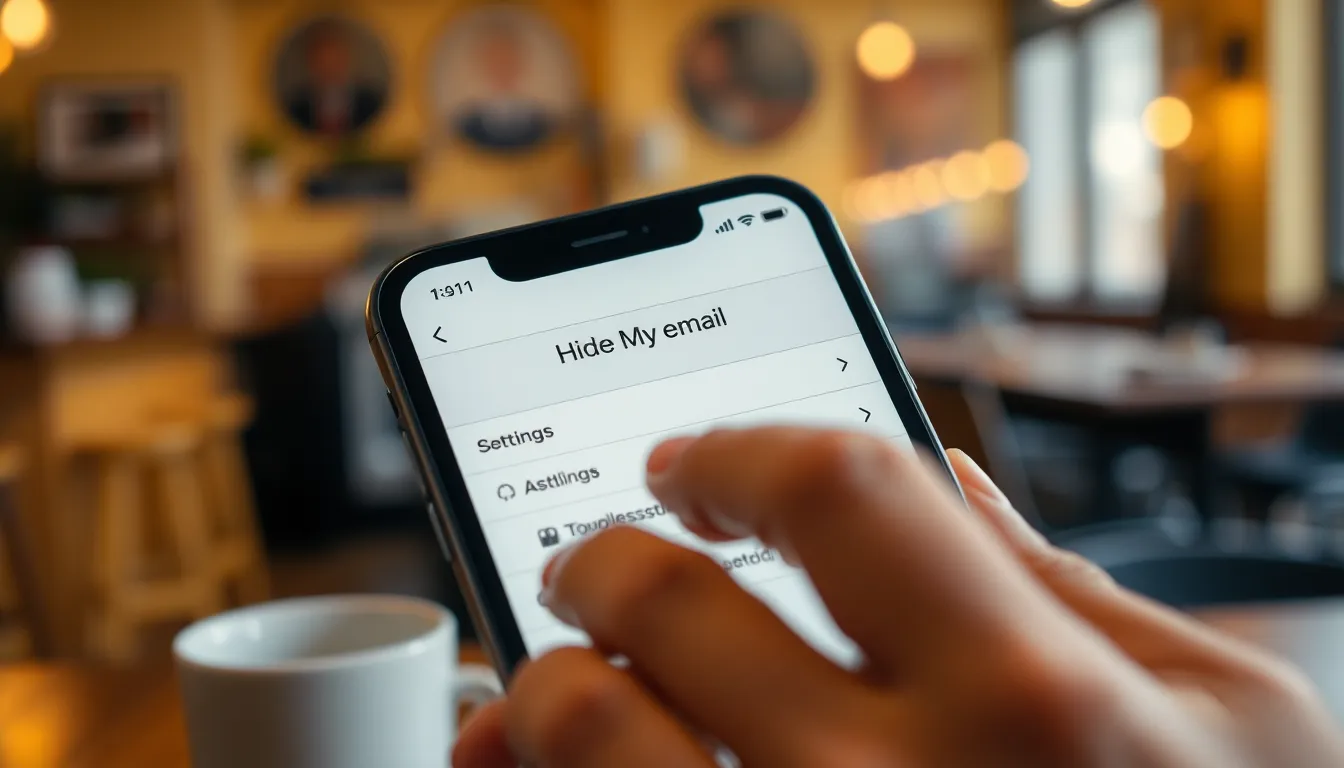In a world overflowing with spam and unsolicited messages, finding a way to safeguard personal information feels like a superhero mission. Enter the iPhone’s “Hide My Email” feature, your trusty sidekick in the battle against inbox clutter and privacy invasion. But where exactly can you find this digital cloak of invisibility?
Table of Contents
ToggleOverview of Hide My Email
“Hide My Email” allows users to create unique, random email addresses. Users can forward all messages sent to these addresses to their actual inbox. This feature helps protect personal email from unwanted contacts.
Privacy stands as a major benefit of using “Hide My Email.” Many seek to avoid spam and safeguard their information. Every time a user signs up for a service, they can generate a new email address.
Managing these generated addresses is straightforward. Users can track, delete, or disable them within the settings. Identifying which addresses link to specific services aids in maintaining control over privacy.
Integration with Apple services increases utility. Accessible through the Mail app and Safari, it offers seamless usage across multiple platforms. When browsing the web, options to generate an email appear during sign-up forms.
Users who prefer enhanced security appreciate this feature. The ability to shield their primary email addresses fosters a sense of security against data breaches. Many take advantage of this feature for online shopping and subscriptions.
Switching between private and public emails becomes easy. Users can decide when to disclose their actual email address. As privacy concerns grow, this feature’s importance continues to rise.
Finding “Hide My Email” is simple. It’s located within the user’s iCloud settings under “Mail.” Overall, this tool provides a practical solution for navigating today’s digital landscape.
Accessing Hide My Email on iPhone

Finding “Hide My Email” on an iPhone is straightforward. This feature provides users with enhanced privacy by generating unique email addresses.
Using the Settings App
To access “Hide My Email,” open the Settings app first. Scroll down to tap on your Apple ID, which is located at the top of the menu. Selecting iCloud brings users to various iCloud features. Next, choose Mail, then tap on “Hide My Email.” Users can see a list of existing addresses created for different services, making it easy to manage them efficiently.
Using the Mail App
Open the Mail app to leverage “Hide My Email” while composing messages. When composing a new email, tap on the “From” field. Users will notice the option to select a “Hide My Email” address. Choosing one of these addresses sends messages from a private email, keeping personal information secure. This integration facilitates seamless communication without exposing personal email addresses.
Benefits of Hide My Email
“Hide My Email” offers significant advantages for iPhone users seeking to enhance their online privacy and security. This feature streamlines how individuals manage their personal information while navigating various services.
Privacy Protection
Privacy protection stands as a key benefit of “Hide My Email.” Users create unique email addresses that divert messages to their actual inboxes. This method prevents others from accessing their true email addresses. The feature shields personal information when signing up for newsletters or online services. Individuals gain peace of mind knowing companies cannot misuse their primary email addresses. When users engage with unfamiliar platforms, generating separate email addresses remarkably decreases the likelihood of unwanted exposure. Utilizing “Hide My Email” allows users to retain control over interactions, thereby fostering a safer digital experience.
Reducing Spam
Reducing spam emerges as another significant benefit associated with “Hide My Email.” Users effectively minimize unsolicited emails by generating a distinct address for each service or subscription. Spammers can’t reach individuals through these randomly generated addresses, which offers an efficient defense against excessive promotional emails. This functionality simplifies inbox management and declutters communication channels. Notably, if a user starts receiving spam on a specific address, they can easily delete it without affecting their primary inbox. This proactive approach helps maintain a streamlined email experience, contributing to overall satisfaction with online communications.
Limitations of Hide My Email
“Hide My Email” offers enhanced privacy but has some limitations. First, it only functions within Apple services, like the Mail app and Safari. Users can’t send emails from third-party email apps using this feature. Second, the random email addresses created may not be recognizable to recipients. This could lead to confusion or missed messages if recipients do not recognize the address.
Another limitation involves potential issues with account recovery. If a user loses access to their randomly generated email address, they might struggle to recover accounts tied to that address. Users should keep track of which addresses they create to avoid this issue. Additionally, some websites may require confirmation through real email addresses, making the generated emails less useful in certain situations.
Moreover, while “Hide My Email” helps reduce spam, it doesn’t eliminate it completely. Users may still receive unwanted messages if the service provider sells email data. Privacy protection offers an added layer of security, yet it cannot guarantee freedom from all spam-related issues.
“Hide My Email” on iPhone is a powerful feature that empowers users to maintain their privacy in a digital world filled with unsolicited messages. By creating unique email addresses for various services, individuals can effectively manage their personal information and reduce spam. This functionality not only enhances security but also simplifies communication management.
While it’s essential to be aware of its limitations, the benefits of using “Hide My Email” far outweigh the drawbacks. Users can enjoy a more organized inbox and a safer online experience by leveraging this tool. Embracing this feature is a step toward greater digital privacy and control over personal data.






